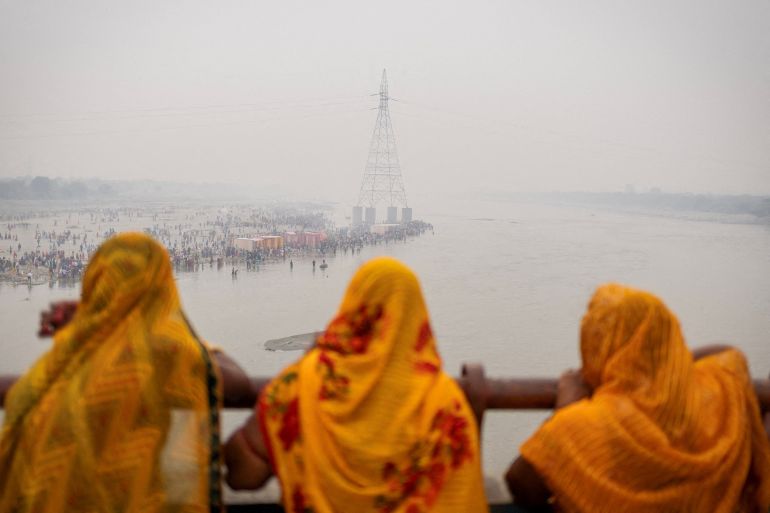Why is New Delhi making it rain artificially?
Delhi is using ‘cloud seeding’ in a bid to dispel pollution – but can it work?

By Yashraj Sharma and News Agencies
Published On 29 Oct 202529 Oct 2025
Save
New Delhi, India – It is that time of year again in the capital of the world’s most populous nation, when 40 million people cough and splutter through toxic pollution for weeks on end.
These days, it is like clockwork. At the onset of every winter, a grey haze hovers over New Delhi and its nearby satellite towns – a toxic mix of exhaust, smoke, and dust that blurs skylines and stings the lungs.
It comes one week after the skies were lit up with firecrackers – which added to the fumes – as people celebrated the annual Hindu festival of light, Diwali. Delhi’s new government, led by Narendra Modi’s Bharatiya Janata Party, believes the answer – perhaps now for mitigation, rather than preventing – lies in making it rain, artificially, by “seeding clouds” in order to clear away the fumes.
What is the Delhi government doing?
On Tuesday afternoon, a small aircraft sprinkled the clouds over Delhi with small quantities of silver iodide and sodium chloride compounds to trigger artificial rain.
The cloud seeding trial aims to tackle the deteriorating air quality in the national capital during the winter months.
An aircraft took off from Kanpur, a city in Uttar Pradesh, 500km away from New Delhi. In consultation with scientists at the city’s Indian Institute of Technology (IIT) branch, it carried out the cloud-seeding exercise over part of the capital.
Last week, the government conducted a test flight and reported it was a success. Delhi chief minister Rekha Gupta called it a “necessity” for Delhi and a pioneering step toward addressing New Delhi’s persistent environmental challenges.

Why is Delhi choking?
Every winter, Delhi’s air turns into a dense, toxic mix of dust, smoke and chemicals.
Advertisement
As temperatures drop, slow winds and a weather pattern called “temperature inversion” trap pollutants close to the ground.
Fine particles known as PM2.5, which are tiny enough to enter the bloodstream, build up from emissions from vehicles, factories and construction dust, and crop stubble burning in nearby agricultural states adds plumes of black carbon and smoke.
These mix with gases, such as nitrogen dioxide and sulphur dioxide in the air, to form new, even more harmful particles. The result is a grey, choking haze that blankets the city.
The deadly mix of airborne particles damages the lungs, and prolonged exposure has been linked to heart and lung diseases, respiratory infections, and adverse birth outcomes.
Diwali firecrackers only added to the breathlessness as Delhi lived up to its reputation as one of the world’s most polluted cities.

How does cloud seeding work?
In a way, it is akin to “nudging” the sky into raining. Scientists pick a cloud to “seed”, depending on its type, its height, the status of the atmosphere and stratification, and estimate the moisture distribution.
Then, loaded planes or drones spray tiny particles of salt, usually silver iodide, into moisture-filled clouds. These act like “seeds”, providing water vapour with something to cling to. As more droplets gather around these particles, they grow heavier until they fall as rain – hopefully washing away the low-hanging pollution as they do.
On Tuesday, images shared by the Indian Institute of Technology, Kanpur showed substances being released from flares attached to an aircraft as it flew in a cloudy sky.
Does it work?
Scientific results have been mixed. Cloud seeding cannot create natural clouds, and the evidence that seeding reliably increases rainfall remains weak and contested, noted Shahzad Gani and Krishna AchutaRao, professors at the Centre for Atmospheric Sciences, IIT Delhi, in a column for The Hindu on October 24.
Plus, experts worry that a significant accumulation of these salts in the soil after rain could actually be harmful to the ecosystem.
The artificial rain can also only provide temporary respite, experts argue, against an ever-lasting problem in New Delhi.
“Cloud seeding is just another gimmick in a series of similar unscientific ideas, like smog towers, suggesting that flashy interventions can substitute for serious, structural solutions,” Gani and AchutaRao wrote.
Advertisement

